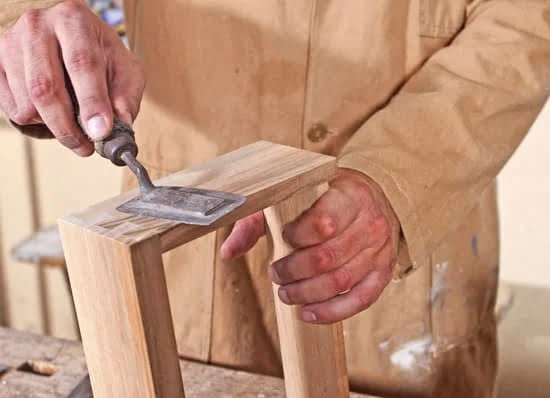Woodworking is a craft that requires precision, skill, and careful attention to detail. Whether you are a professional woodworker or simply enjoy woodworking as a hobby, one thing is certain – clamps are essential tools. Clamps provide the necessary pressure to hold pieces of wood securely together while glue dries or joints are being fastened. They ensure that your projects come out perfectly aligned and stable.
In this article, we will explore the different types of clamps used in woodworking and their specific applications. From versatile bar clamps to handy spring clamps, we will discuss the strengths and uses of each type. We will also provide expert tips for choosing the right clamps for your woodworking projects, as well as maintenance and care guidelines to extend their lifespan.
Additionally, we will highlight the top must-have clamps that every woodworker should own. Whether you need an indispensable tool for gluing and assembly like parallel clamps, a reliable one-handed solution like quick-grip clamps, or a clamp specialized for securing wood edges and joinery like edge clamps – we have got you covered.
So if you are ready to take your woodworking to the next level and ensure flawless results every time, read on to discover the world of must-have clamps for woodworking. Their versatility and applications will revolutionize your projects and make your woodworking experience more efficient and enjoyable.
Different Types of Clamps Used in Woodworking
The success of any woodworking project often relies on the proper use of clamps. Clamps play a crucial role in holding pieces together firmly during gluing, sanding, or assembly processes. They help ensure accuracy, stability, and overall quality in the final product. In woodworking, there are various types of clamps to choose from depending on the task at hand.
Bar Clamps: The Versatile Workhorse in Woodworking
One of the most common types of clamps used in woodworking is the bar clamp. These clamps feature a long metal bar with adjustable jaws that can be tightened using a screw mechanism. Bar clamps are known for their versatility, as they can handle both light and heavy-duty projects.
They come in various sizes and lengths to accommodate different woodworking needs. The long reach of bar clamps makes them ideal for tasks such as panel glue-ups, where a large surface area needs even pressure distribution.
Pipe Clamps: Ideal for Large-Scale Projects and Versatility
Another popular option is the pipe clamp. As the name suggests, these clamps utilize standard plumbing pipes as their main component. The key advantage of pipe clamps is their affordability and adaptability to different project sizes. By simply swapping out longer or shorter pipes, woodworkers can extend or reduce the length of their clamping capacity as needed. Pipe clamps excel in maintaining consistent pressure over large-scale projects like table construction or laminating wide panels.
C-Clamps: Handy and Convenient for Various Woodworking Tasks
C-clamps are another staple in a woodworker’s toolkit due to their convenience and compact design. These clamp types have a C-shaped frame with an adjustable threaded screw mechanism that tightens against one fixed jaw.
C-clamps are highly versatile and can be used across a wide range of projects requiring moderate pressure application, such as securing small joinery or holding workpieces during light carving or shaping tasks. Their compact size makes them suitable for use in confined spaces where larger clamps may not fit.
Spring Clamps: The Clamps for Quick and Temporary Holding
When it comes to quick and temporary holding, spring clamps come to the rescue. These clamps are designed with a “trigger” mechanism that allows easy one-handed operation. They have jaws lined with plastic or rubber, providing a non-marring grip on delicate surfaces. Spring clamps are commonly used in small-scale projects, such as attaching wooden trim, holding down jigs or templates, and securing light pieces for painting or finishing.
F-Clamps: The Go-To Choice for Strong and Steady Holding
F-clamps, also known as bar clamps or speed clamps, are widely favored by woodworkers for their strength and stability. Featuring an F-shaped bar design, these clamps provide strong and steady holding power. F-clamps typically have a quick-release mechanism that allows for fast adjustments when necessary. They are commonly used in woodworking tasks like edge gluing, frame assembly, or securing workpieces to a workbench.
Choosing the Right Clamps for Your Woodworking Projects
Choosing the right clamps for your woodworking projects is essential to ensure that your workpieces are secure and stable during various woodworking tasks. There are several factors to consider when selecting the appropriate clamps for your projects.
Consider the Size and Weight of Your Projects
Before choosing a clamp, it is important to evaluate the size and weight of your woodwork project. Larger and heavier pieces will require stronger clamping pressure and a more robust clamp. Conversely, smaller or lighter projects may only need a smaller clamp with less pressure. By considering the specific requirements of each project, you can select clamps that will provide optimal stability and support.
Match the Clamp Type to the Woodworking Task at Hand
Different woodworking tasks call for different types of clamps. For example, bar clamps are versatile and can be used for a wide range of applications such as gluing, assembly, and holding workpieces in place. Pipe clamps are ideal for large-scale projects that require extended lengths and higher clamping pressures. C-clamps are handy for various woodworking tasks due to their convenient size and shape.
Spring clamps provide quick and temporary holding for lightweight jobs. F-clamps are go-to choices for strong and steady holding during drilling, welding, or cutting activities. By matching the clamp type to the task at hand, you can ensure efficient and effective results in your woodworking projects.
Evaluating the Clamp Quality and Durability
When purchasing clamps, it is important to evaluate their quality and durability. Look for well-constructed clamps made from high-quality materials such as steel or aluminum alloys. Check if the handles or jaws have sufficient grip, ensuring they won’t slip during use.
Consider whether they have smooth operation mechanisms like threaded rods or quick-release triggers. Additionally, read reviews from other woodworkers or seek advice from professionals to gauge the reliability of the clamps. Investing in high-quality and durable clamps will not only provide long-lasting performance but also ensure the safety of your woodworking projects.
By considering the size and weight of your projects, matching the clamp type to the task at hand, and evaluating the clamp quality and durability, you will be able to choose the right clamps for your woodworking projects. With properly selected clamps, you can achieve precise and secure holding during various woodworking tasks such as gluing, assembly, or drilling. In the next section, we will discuss some must-have clamps that every woodworker should own.
Top 5 Must-Have Clamps Every Woodworker Should Own
The success of any woodworking project relies heavily on the use of proper clamping techniques and tools. With so many options available in the market, it can be overwhelming to choose the right clamps for your woodworking projects. However, there are a few must-have clamps that every woodworker should own due to their versatility and usefulness. Here are the top 5 must-have clamps for woodworkers:
- Parallel Clamps: Parallel clamps are an indispensable tool for gluing and assembly tasks in woodworking. These clamps provide even pressure along the entire length of the workpiece, resulting in strong and stable joints. They are known for their excellent holding power and precise positioning capabilities.
- Quick-Grip Clamps: Quick-grip clamps are a reliable one-handed clamping solution that every woodworker should have in their toolkit. These clamps feature a quick-release trigger mechanism that allows for easy adjustment and fastening with just one hand. They are perfect for holding together small or delicate pieces during glue-ups.
- Band Clamps: Band clamps are essential when working with irregular shapes and compound angles in woodworking projects. These clamps consist of a nylon webbing or band that can be wrapped tightly around the workpiece, providing even pressure from all directions. They are ideal for glue-ups involving complex shapes or multiple pieces.
- Edge Clamps: When it comes to securing wood edges and joinery, edge clamps are your go-to choice. These clamps have adjustable jaws that can be aligned perfectly with the edges of the workpiece, ensuring tight and accurate bonding during glue-ups or edge-to-edge joinery.
- Jorgensen Cabinet Master Clamps: For larger projects like building cabinets or furniture, Jorgensen Cabinet Master Claps are considered the ultimate clamp option. These heavy-duty clamps have a large throat depth, allowing them to reach deep into cabinets while providing ample pressure for strong and sturdy joints.
Having these top 5 must-have clamps in your woodworking arsenal will greatly enhance your project outcomes. Whether you are a beginner or an experienced woodworker, investing in these clamps will make your work easier, more efficient, and ultimately produce better results.
Expert Tips and Techniques for Effective Clamp Usage in Woodworking
Woodworking clamps are an indispensable tool for any woodworker, allowing for secure and precise holding of workpieces during various woodworking tasks. While having the right clamps is important, using them effectively can make a significant difference in the overall success of your projects. In this section, we will explore some expert tips and techniques for maximizing clamp usage in woodworking.
a. Properly Preparing and Cleaning the Workpiece before Clamping: Before applying clamps to your workpiece, it is crucial to properly prepare and clean the surfaces that will be clamped together. This involves removing any dirt, debris, or adhesive residue that may hinder the effectiveness of the clamping process. Additionally, ensuring that both surfaces are flat, smooth, and free of imperfections will allow for optimal contact between the workpiece and clamps.
b. Achieving Adequate Pressure without Over-Tightening: Finding the sweet spot when it comes to clamp pressure is essential. While you want to ensure that there is enough pressure to securely hold your workpiece in place, over-tightening can lead to damage or distortion of the wood. It is recommended to gradually apply pressure on the clamp until you achieve a firm hold without straining the materials.
c. Utilizing Padding and Blocks for Protecting the Wood Surface: When clamping delicate or finished surfaces, it is important to protect them from potential damage caused by direct contact with metal clamps. Placing padding such as felt or leather between the clamp jaws and the workpiece can prevent marks or indentations from occurring. Additionally, using blocks as support beneath the clamp jaws can distribute pressure more evenly across the surface.
d. Creating Jigs and Fixtures to Optimize Clamp Utility: Jigs and fixtures can greatly enhance clamp utility by providing additional support and precise alignment during woodworking tasks. By constructing custom jigs or fixtures specific to your project, you can improve the efficiency and accuracy of your clamping process. Whether it’s a jig for edge gluing or a fixture for holding angled pieces together, these tools can make a significant difference in the quality of your work.
By employing these expert tips and techniques, you can maximize the effectiveness and efficiency of your clamp usage in woodworking. Properly preparing and cleaning workpieces, achieving adequate pressure without over-tightening, utilizing padding and blocks for protection, and creating jigs and fixtures are all key elements to consider when using clamps. Incorporating these practices into your woodworking routine will help ensure successful and professional results.
Maintenance and Care
Proper maintenance and care play a crucial role in extending the lifespan of your clamps and ensuring their optimal performance. By following these simple steps, you can prevent corrosion, rust, bending, or distortion, and keep your clamps in top shape for many woodworking projects to come.
a. Regular Cleaning and Inspection to Prevent Corrosion and Rust: Over time, dust, debris, glue residue, or moisture can accumulate on your clamps, leading to corrosion or rust. It is important to clean your clamps after each use.
Use a soft brush or cloth to remove any dirt or residue from the clamp surfaces and moving parts. For stubborn grime or glue, a mild solvent like mineral spirits can be used. After cleaning, make sure to thoroughly dry the clamps before storing them.
b. Lubricating Moving Parts for Smooth Clamp Operation: Proper lubrication is key to ensuring smooth operation of your clamps. Apply a small amount of lubricant, such as silicone spray or oil-based lubricant, to the moving parts of your clamps regularly. This will prevent friction and sticking that could lead to damage over time. Remember to wipe off any excess lubricant after application.
c. Proper Storage to Avoid Bending or Distortion: When not in use, it is important to store your clamps properly to avoid bending or distortion. Hang smaller bar clamps on a rack using hooks or keep them in a designated drawer with dividers for organization. For larger pipe clamps or F-clamps, consider using a wall rack system that can securely hold their weight without causing strain on the bars.
| Clamp Maintenance Tips |
|---|
| Regularly clean and inspect clamps |
| Use a mild solvent for stubborn grime |
| Dry clamps thoroughly before storage |
| Lubricate moving parts with silicone spray or oil-based lubricant |
| Wipe off excess lubricant after application |
| Store clamps properly to avoid bending or distortion |
By following these maintenance and care practices, you can ensure that your clamps remain in excellent condition, allowing for smooth and reliable operation when tackling your woodworking projects. Taking the time to properly maintain your clamps will ultimately save you money by extending their lifespan and avoiding the need for frequent replacements.
Budget-Friendly Alternatives to High-End Clamps for Woodworking
Pipe Clamp DIY: Creating Your Own Affordable Pipe Clamps
For woodworkers on a budget, creating your own pipe clamps can be a cost-effective alternative to purchasing high-end clamps. Pipe clamps are ideal for larger woodworking projects and offer versatility in their applications. The good news is that with a few simple materials and some basic tools, you can easily create your own pipe clamps.
To make your DIY pipe clamp, you will need a section of threaded pipe, pipe fittings such as tees and elbows, two pieces of hardwood for the jaws, and some screws or carriage bolts. Start by cutting the hardwood into two equal-sized pieces to serve as the jaws of the clamp. Next, drill holes in each jaw that match the diameter of the threaded pipe.
Attach one jaw to an elbow fitting on one end of the pipe and secure it using screws or carriage bolts. Then attach the other jaw to another elbow fitting at the other end of the pipe.
Once your homemade pipe clamp is assembled, you can adjust its length by screwing more sections of threaded pipe together. This flexibility allows you to accommodate different sizes of woodworking projects. Remember to tighten all fittings securely before using the clamp to ensure stability and proper functioning.
Using Wooden Handscrews as Economical yet Effective Clamping Solution
Wooden handscrews are another affordable option for woodworkers who are looking for budget-friendly clamping solutions. These versatile clamps consist of two wooden jaws connected by a central spindle that can be moved apart or brought closer together by turning handles at each end.
To use wooden handscrews effectively, align your workpiece between the wooden jaws and turn both handles clockwise until adequate pressure is applied. The unique design of handscrews provides excellent stability and evenly distributed pressure across the workpiece, making them suitable for various woodworking tasks such as gluing, assembly, or edge joining.
Wooden handscrews can be easily found at local hardware stores or online, and they come in different sizes to accommodate different project requirements. While they may not provide the same level of convenience or precision as high-end clamps, they are a cost-effective option for woodworkers on a budget who need reliable clamping tools.
Resourceful Workarounds for Temporary Clamping Needs
In some woodworking situations, temporary clamps are needed to hold pieces together during assembly or to secure parts while waiting for glue to dry. While it is always advisable to use purpose-built clamps for these tasks, there are resourceful workarounds that can serve as temporary clamping solutions if you don’t have the specific tools on hand.
For example, spring clips like binder clips or clothespins can be useful for holding lightweight materials temporarily. These can be attached to the edges or corners of your workpiece to keep them in place while you continue working. Another option is using straps made from webbing or nylon belts to secure larger pieces together. Simply wrap the strap tightly around the pieces and secure it with a buckle or knot.
While these makeshift solutions may not provide the same level of stability and precision as dedicated clamps, they can be effective in a pinch and save you money on purchasing additional clamps for temporary needs.
By being resourceful and considering alternative options, woodworkers on a budget can still achieve satisfactory clamping results without breaking the bank. Whether it’s DIY pipe clamps, wooden handscrews, or creative workarounds, there are budget-friendly alternatives available that can get the job done effectively.
Conclusion
In conclusion, clamps are an essential tool for every woodworker. They provide stability, hold pieces together, and ensure accuracy during woodworking projects. With the wide range of clamp types available, it’s important to choose the right ones for your specific needs.
Bar clamps, such as parallel clamps, are versatile and perfect for gluing and assembly tasks. Pipe clamps offer versatility for larger projects, while C-clamps are handy and convenient for various woodworking tasks. Spring clamps provide quick and temporary holding, while F-clamps are known for their strong and steady grip.
When choosing clamps, consider the size and weight of your projects. Match the clamp type to the specific woodworking task at hand. Evaluate clamp quality and durability to ensure they will withstand rigorous use over time.
Expert tips and techniques can further enhance effective clamp usage in woodworking. Properly preparing and cleaning the workpiece before clamping is crucial. Achieving adequate pressure without over-tightening is also important to avoid damaging the wood surface. Utilizing padding and blocks can protect the wood from clamp marks or indentations. Creating jigs and fixtures can optimize the utility of your clamps.
To extend the lifespan of your clamps, regular cleaning and inspection is necessary to prevent corrosion and rust. Lubricating moving parts ensures smooth operation. Storing them properly prevents bending or distortion.
While high-end clamps may be preferred by many woodworkers, there are budget-friendly alternatives available as well. DIY pipe clamps can be created affordably, wooden handscrews can serve as economical yet effective options, and resourceful workarounds exist for temporary clamping needs.

Hi everyone! I’m a woodworker and blogger, and this is my woodworking blog. In my blog, I share tips and tricks for woodworkers of all skill levels, as well as project ideas that you can try yourself.





